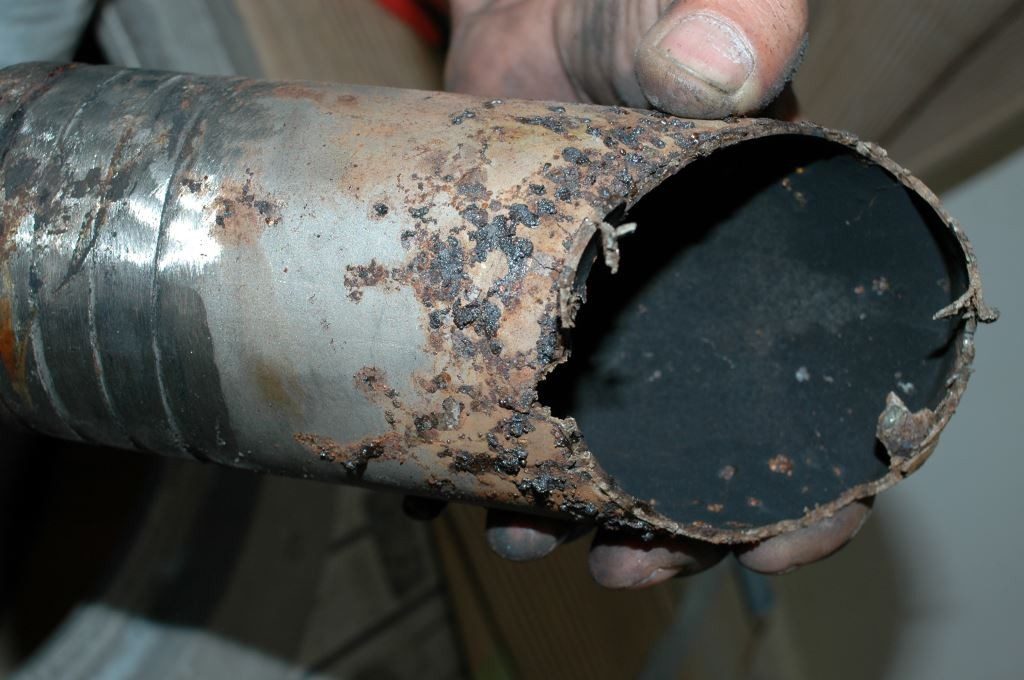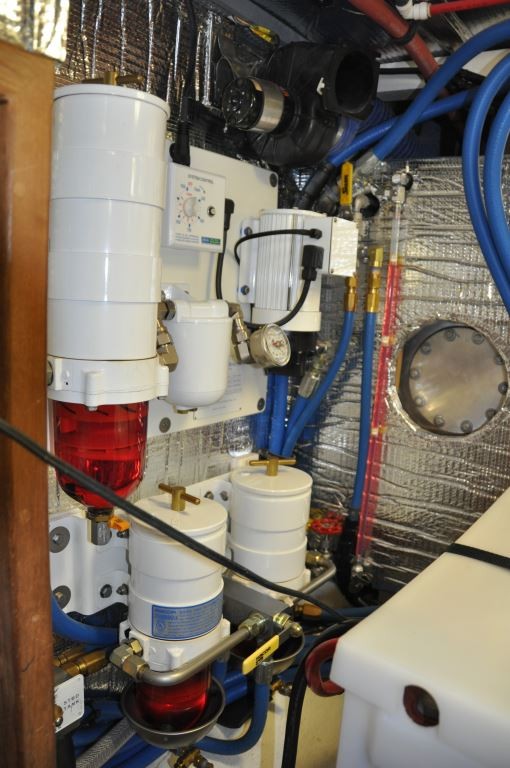Photo Essay: Below the Waterline Welded Stainless Steel; Does it Make Sense?
I’ve written about stainless steel; its strengths and weaknesses, on many occasions, in the Marine Systems Excellence eMagazine as well as for other publications While I don’t profess to have a lock on educating boat builders and yards, I remain puzzled over their frequent use of this metal (particularly the latter in that they are more likely to see the failures) in applications wherein a failure would lead to flooding, often catastrophic. While stainless steel is invaluable, and used successfully in scores of onboard applications, conveyance of raw water is, ideally, not one of them.
In many ways I do understand the reasons for its frequent application, it’s easy to fabricate into custom shapes for plumbing, exhaust and shaft logs; and initially it looks good. However, stainless steel’s failure mode is insidious in that it very often decays where it is most difficult to inspect, where it’s exposed to stagnant water, often at the interface between hardware and hull.

While exhaust risers and mixing nozzles are often made from 316L stainless steel, and more exotic alloys, failures are often a slow process, they begin with brown stains and weeping from welded joints. Failures can be a heartache, and expensive, however, rarely do they lead to uncontrolled flooding. Below the waterline components like exhaust outlets, and other submerged fittings and plumbing, are on the other hand, an entirely different matter. A failure here nearly always results in flooding.
I have yet to encounter an application where a stainless steel exhaust outlet is used, where it could not be made from fiberglass, and in many cases at lower cost. If you are purchasing a boat, new or used, look closely at this component. If you are having a boat built, and stainless steel is used in these applications, plumbing, pipe, exhaust outlets, or shaft logs etc. ask the builder about more suitable alternatives such as fiberglass or bronze.
Ask Steve
Steve:
I have just had my boat surveyed for insurance purposes. Most recommendations are easily dealt with, but he has come down hard on my fuel tank sight gauges. He believes the material could fail in the event of a fire, and possibly contribute diesel fuel to the fire. I’ve attached a couple of photos of what I have. The previous owner installed 4 new aluminum tanks on the vessel (Krogen 42, 1985). Each tank has a gauge with petcocks on either end, with a flexible “plastic” material of unknown composition. I should add that some of the petcocks “weep” if left “open”, so I ensure they are closed. I should probably consider a replacement for the petcocks. What material do you recommend? Is Teflon an acceptable material? How should they be shielded?
Jim Cave
Jim:
The surveyor’s observation is a bit curious, as virtually no clear hose material I’ve encountered meets the ABYC 2.5 minute flame exposure standard. However, it is for this reason that ABYC Standards also mandate that sight glasses be equipped with valves at the top and bottom, and that these valves remain closed other than when checking fuel level.
ABYC H-33.5.8 A means to determine fuel level or quantity shall be provided.
33.5.8.1 If a sight gauge is used,
33.5.8.1.1 it shall be equipped with a shut-off valve at the top and at the bottom of the gauge, and
33.5.8.1.2 a warning label shall be placed adjacent to the sight gauge, and
With the valves closed only the quantity of fuel contained within the sight glass can leak (into the fire). There is no requirement per se for the makeup of the hose itself used for the sight glass. Thus, it would seem your system is primarily compliant.
The leak should be corrected, and your fuel polishing system filter bowl requires a heat shield and a plug in the drain valve. Also, while it’s unused and capped, and thus probably not an issue, strictly speaking, the gate valve shown in one of the photos lacks ABYC compliance. Gate valves lack compliance because their condition, open or closed, cannot be determined by merely looking at them. They should not be used in fuel systems.


Hey Steve,
I always enjoy your articles. I could use a bit of help. I friend of mine is building a 54 foot steel sailboat and is almost ready to begin the electrical wiring. Being an electrician myself, I am a marine electrician as well as commercial and industrial and I have an ABYC manual for reference.
Long story short, he would like me to help him wire up the yacht. He was a yard manager at Brooklin Boatyard and a certified welder.
Can you suggest some books or tech literature I can reference so I can do it correctly…especially the whole ac/dc grounding/bonding issue? I have already suggested an isolation transformer, but that’s just the tip of the iceberg.
Help me if you can, go in the right direction. He has offered to take me to the islands when it’s finished…I want to make sure I don’t screw it up.
Thanks,
Tom Curran
Tom:
I’m going to use this question in my Ask Steve column, as many readers will benefit from the response. While there are a number of texts that may be beneficial the one I’ve consistently recommended is Charlie Wing’s “Illustrated Boat Owner’s Electrical Handbook” 2nd edition. Among other things this book walks readers through the complexities of marine electrical systems in straightforward and easy to understand terms (something that’s missing from other notable marine technical books). It includes sections on AC and DC wiring as well as corrosion prevention.
Having said all that, it will be critically important for you to thoroughly understand and implement all relevant ABYC Standards., to ensure the vessel’s electrical system is safe and reliable.
Finally, you may find this column on AC neutral to ground connections of interest. http://proboat.com/2011/10/demystifying-the-neutral-to-ground-connection/
Steve:
Currently mounting an aluminum Edson radar support on my aluminum mizzen mast, with support having provision for twelve 3/16″ rivets. Do you advise aluminum rivet with aluminum mandrel, or stainless rivet with stainless mandrel with Tufgel application to diminish potential electrolysis; the stainless rivet having 2-3 times the shear and tensile strength of aluminum. My own feeling is that the 500 lb shear and 450 lb tensile strength/aluminum rivet (per Hanson specs.) should be more than adequate, avoiding any risk of electrolysis.
Thank you for what you do.
Robert L. Marcus, M.D.
Dear Rob:
The primary concern in an installation such as this is poultice corrosion, corrosion that is peculiar to aluminum, it occurs when the paint on a mast or bracket is breached or fractured by the fastener, rivet, screw etc. In order for aluminum to remain corrosion resistant, it must be exposed to oxygen, which enables it to form a tough, oxide film. However, when water migrates under the paint breach, it interacts with the aluminum, and because the area is not exposed to air, the aluminum corrodes, developing the familiar white, frothy, aluminum hydroxide, which in turn further lifts the paint, creating a larger and larger, and more unsightly, paint blister or bubble.
For the most part this is easily prevented by liberally bedding fasteners and brackets in polyurethane or polysulfide bedding compound. The bedding compound fills paint breaches, thereby preventing poultice corrosion from ever achieving toehold.
While proprietary thread compounds effective at preventing thread seizure, for stainless fasteners threaded into aluminum substrates, they simply act as an insulator between the two, while excluding moisture. They do nothing to prevent the paint breach issue, and any virtually compound, including the aforementioned sealants, that fill the gap between threads will accomplish the same goal.
For more on this subject see the column I wrote entitled, “Paint and Aluminum, Ensuring a Good Mix” https://stevedmarineconsulting.com/paint-and-aluminum-how-to-ensure-a-good-mix-2/.
Hi Steve,
On a 38’ sportfisher build we’re planning a 2” through-hull fitting & seacock in the aft bilge going into a strainer/filter to supply raw water to a deckwash faucets pump, bait livewell pump, freezer compressor condenser circulation pump and possibly a water maker.
My question is about mounting height for the strainer. Forespar/Marelon says; “Water Strainers should be installed a minimum of 12 inches (305 mm) above the static (vessel moored) waterline when- ever possible”, and Vetus says 6” above water line. The problem is that the water pumps supplying these systems run only intermittently and the pump manufacturers claim they can never run dry else risk loss of pump prime or damaging the pump. Without a complex array of airtight one-way valves it is likely air will be drawn back into an above waterline strainer when the pumps are off. I doubt these smaller pumps would be able to consistently pull enough vacuum to draw water 12” above sea level (especially the freezer condenser cooling pump – a 0.25” ID outlet magnetic drive pump supplying a trickle of raw water to the compressor when needed). I conclude that the only solution is to mount the strainer below sea level to be certain it is always flooded to assure uninterrupted water supply to these pumps.
Steve, do you see anything wrong with mounting the strainer below sea level?
And thank you for the unique information you generously supply for the marine industry. You provide that rare and hard-earned truth of real world experience to designers, technicians and boat owners – a valued compliment our “textbook” training.
Tony Dean
Tony:
You’ve posed a good question, and I must also commend you for reading the manufacturer’s installation instructions, something far too few marine industry professionals do. I strongly suspect this requirement, from these manufacturers, is designed to minimize the possibility of flooding and sinking in the event the strainer fails, or is assembled incorrectly (I’ve seen this happen, the basket is installed incorrectly and it prevents the lid from sealing, a boat sank overnight at the Annapolis Boat Show for this reason several years ago). They can, therefore, be forgiven for this recommendation or requirement, to an extent. Having said that, aboard most vessels, an installation requirement of this sort, or installing a vented loop after the pump, which would keep the pump full of water, would be inconvenient at best, and onerous at worst. In fact, I might be able to count on one hand the number of strainers for systems of this sort I’ve encountered that were mounted above the waterline.
To answer your question, I agree, check valves and/or risers are cumbersome and trouble-prone, it’s not a route I’d take, and it will make life hard on non-self-priming pumps. The Forespar product at least leaves you an option for below the waterline mounting, without violating the installation instructions, making that a viable option, while remaining compliant. If you chose to use the Vetus product, knowingly in violation of their instructions, you’d probably be no worse off, you simply wouldn’t be compliant with their instructions and any failure would be your responsibility.
You do have a high water alarm in every compartment, right? Is it wirelessly enabled to send a text message in the event of flooding? If not, these systems are now affordable enough to warrant their installation on almost any vessel.



